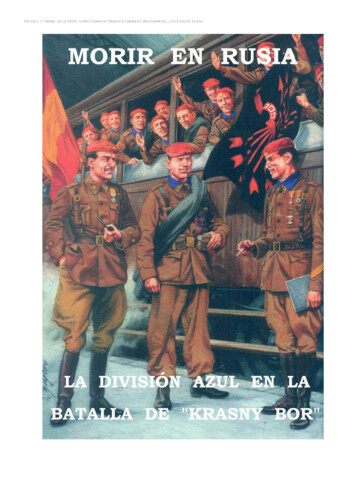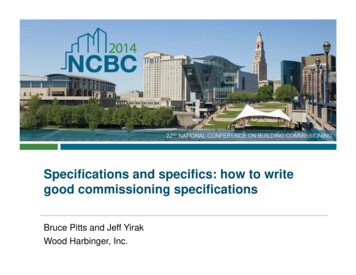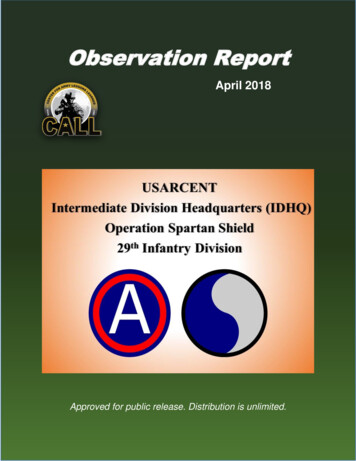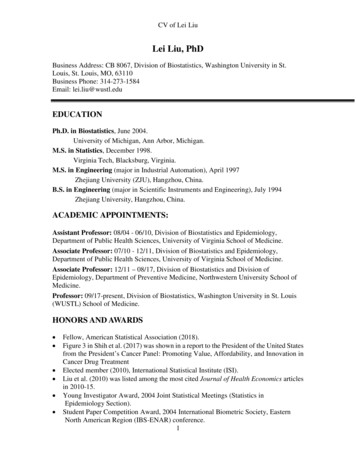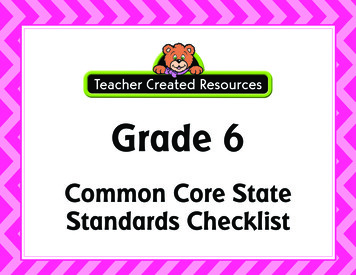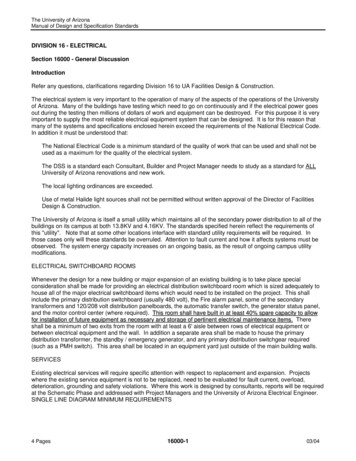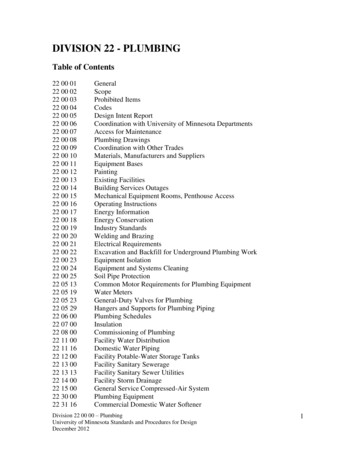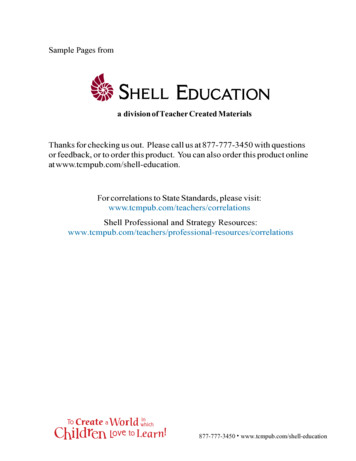
Transcription
Sample Pages froma division of Teacher Created MaterialsThanks for checking us out. Please call us at 877-777-3450 with questionsor feedback, or to order this product. You can also order this product onlineat www.tcmpub.com/shell-education.For correlations to State Standards, please visit:www.tcmpub.com/teachers/correlationsShell Professional and Strategy ources/correlations877-777-3450 www.tcmpub.com/shell-education
Great Works Literature Guides Island of the Blue DolphinsScottScottO’DellO’Dell
Table of ContentsHow to Use This Literature Guide . . . . . . . . . . . . . . . . . . . . . . . . . . . . . . . . . . . . 4Theme Thoughts. . . . . . . . . . . . . . . . . . . . . . . . . . . . . . . . . . . . . . . . . . . . . . . . .Vocabulary. . . . . . . . . . . . . . . . . . . . . . . . . . . . . . . . . . . . . . . . . . . . . . . . . . . . . .Analyzing the Literature. . . . . . . . . . . . . . . . . . . . . . . . . . . . . . . . . . . . . . . . . .Reader Response. . . . . . . . . . . . . . . . . . . . . . . . . . . . . . . . . . . . . . . . . . . . . . . . .Close Reading the Literature. . . . . . . . . . . . . . . . . . . . . . . . . . . . . . . . . . . . . . .Making Connections . . . . . . . . . . . . . . . . . . . . . . . . . . . . . . . . . . . . . . . . . . . . .Creating with the Story Elements. . . . . . . . . . . . . . . . . . . . . . . . . . . . . . . . . . .Culminating Activity. . . . . . . . . . . . . . . . . . . . . . . . . . . . . . . . . . . . . . . . . . . . .Comprehension Assessment. . . . . . . . . . . . . . . . . . . . . . . . . . . . . . . . . . . . . . .Response to Literature. . . . . . . . . . . . . . . . . . . . . . . . . . . . . . . . . . . . . . . . . . . .4566677888Correlation to the Standards. . . . . . . . . . . . . . . . . . . . . . . . . . . . . . . . . . . . . . . . . . 8Purpose and Intent of Standards . . . . . . . . . . . . . . . . . . . . . . . . . . . . . . . . . . . 8How to Find Standards Correlations. . . . . . . . . . . . . . . . . . . . . . . . . . . . . . . . 8Standards Correlation Chart. . . . . . . . . . . . . . . . . . . . . . . . . . . . . . . . . . . . . . . 9TESOL and WIDA Standards. . . . . . . . . . . . . . . . . . . . . . . . . . . . . . . . . . . . . 10About the Author—Scott O’Dell. . . . . . . . . . . . . . . . . . . . . . . . . . . . . . . . . . . . . 11Possible Texts for Text Comparisons. . . . . . . . . . . . . . . . . . . . . . . . . . . . . . . 11Book Summary of Island of the Blue Dolphins. . . . . . . . . . . . . . . . . . . . . . . . . 12Cross-Curricular Connection . . . . . . . . . . . . . . . . . . . . . . . . . . . . . . . . . . . . . 12Possible Texts for Text Sets . . . . . . . . . . . . . . . . . . . . . . . . . . . . . . . . . . . . . . . 12Teacher Plans and Student Pages. . . . . . . . . . . . . . . . . . . . . . . . . . . . . . . . . . . . . 13Pre-Reading Theme Thoughts . . . . . . . . . . . . . . . . . . . . . . . . . . . . . . . . . . . .Section 1: Chapters 1–5. . . . . . . . . . . . . . . . . . . . . . . . . . . . . . . . . . . . . . . . . .Section 2: Chapters 6–10. . . . . . . . . . . . . . . . . . . . . . . . . . . . . . . . . . . . . . . . .Section 3: Chapters 11–16. . . . . . . . . . . . . . . . . . . . . . . . . . . . . . . . . . . . . . . .Section 4: Chapters 17–23. . . . . . . . . . . . . . . . . . . . . . . . . . . . . . . . . . . . . . . .Section 5: Chapters 24–29. . . . . . . . . . . . . . . . . . . . . . . . . . . . . . . . . . . . . . . .131424344454Post-Reading Activities. . . . . . . . . . . . . . . . . . . . . . . . . . . . . . . . . . . . . . . . . . . . . 64Post-Reading Theme Thoughts . . . . . . . . . . . . . . . . . . . . . . . . . . . . . . . . . . .Culminating Activity: Wonderful Wildlife. . . . . . . . . . . . . . . . . . . . . . . . . .Comprehension Assessment. . . . . . . . . . . . . . . . . . . . . . . . . . . . . . . . . . . . . .Response to Literature: Fact or Fiction? . . . . . . . . . . . . . . . . . . . . . . . . . . . .64656769Answer Key . . . . . . . . . . . . . . . . . . . . . . . . . . . . . . . . . . . . . . . . . . . . . . . . . . . . . . . 71 Shell Education #40208—Instructional Guide: Island of the Blue Dolphins3
IntroductionHow to Use This Literature GuideToday’s standards demand rigor and relevance in the reading of complex texts. Theunits in this series guide teachers in a rich and deep exploration of worthwhile worksof literature for classroom study. The most rigorous instruction can also be interestingand engaging!Many current strategies for effective literacy instruction have been incorporatedinto these instructional guides for literature. Throughout the units, text-dependentquestions are used to determine comprehension of the book as well as studentinterpretation of the vocabulary words. The books chosen for the series are complexexemplars of carefully crafted works of literature. Close reading is used throughoutthe units to guide students toward revisiting the text and using textual evidence torespond to prompts orally and in writing. Students must analyze the story elementsin multiple assignments for each section of the book. All of these strategies worktogether to rigorously guide students through their study of literature.The next few pages will make clear how to use this guide for a purposeful andmeaningful literature study. Each section of this guide is set up in the same way tomake it easier for you to implement the instruction in your classroom.Theme ThoughtsThe great works of literature used throughout this series have important themes thathave been relevant to people for many years. Many of the themes will be discussedduring the various sections of this instructional guide. However, it would also benefitstudents to have independent time to think about the key themes of the novel.Before students begin reading, have them complete Pre-Reading Theme Thoughts(page 13). This graphic organizer will allow students to think about the themesoutside the context of the story. They’ll have the opportunity to evaluate statementsbased on important themes and defend their opinions. Be sure to have studentskeep their papers for comparison to the Post-Reading Theme Thoughts (page 64). Thisgraphic organizer is similar to the pre-reading activity. However, this time, studentswill be answering the questions from the point of view of one of the characters of thenovel. They have to think about how the character would feel about each statementand defend their thoughts. To conclude the activity, have students compare whatthey thought about the themes before they read the novel to what the charactersdiscovered during the story.4#40208—Instructional Guide: Island of the Blue Dolphins Shell Education
IntroductionHow to Use This Literature Guide (cont.)VocabularyEach teacher overview page has definitions and sentences about how key vocabularywords are used in the section. These words should be introduced and discussedwith students. There are two student vocabulary activity pages in each section. Onthe first page, students are asked to define the ten words chosen by the author ofthis unit. On the second page in most sections, each student will select at least eightwords that he or she finds interesting or difficult. For each section, choose one ofthese pages for your students to complete. With either assignment, you may wantto have students get into pairs to discuss the meanings of the words. Allow studentsto use reference guides to define the words. Monitor students to make sure thedefinitions they have found are accurate and relate to how the words are used inthe text.On some of the vocabulary student pages, students are asked to answer text-relatedquestions about the vocabulary words. The following question stems will help youcreate your own vocabulary questions if you’d like to extend the discussion. How does this word describe ’s character? In what ways does this word relate to the problem in this story? How does this word help you understand the setting? In what ways is this word related to the story’s solution? Describe how this word supports the novel’s theme of . . . . What visual images does this word bring to your mind? For what reasons might the author have chosen to use this particular word?At times, more work with the words will help students understand their meanings.The following quick vocabulary activities are a good way to further study the words. Have students practice their vocabulary and writing skills by creating sentencesand/or paragraphs in which multiple vocabulary words are used correctly andwith evidence of understanding. Students can play vocabulary concentration. Students make a set of cards withthe words and a separate set of cards with the definitions. Then, students laythe cards out on the table and play concentration. The goal of the game is tomatch vocabulary words with their definitions. Students can create word journal entries about the words. Students choosewords they think are important and then describe why they think each word isimportant within the novel. Shell Education #40208—Instructional Guide: Island of the Blue Dolphins5
IntroductionHow to Use This Literature Guide (cont.)Analyzing the LiteratureAfter students have read each section, hold small-group or whole-class discussions.Questions are written at two levels of complexity to allow you to decide whichquestions best meet the needs of your students. The Level 1 questions are typicallyless abstract than the Level 2 questions. Level 1 is indicated by a square, while Level2 is indicated by a triangle. These questions focus on the various story elements, suchas character, setting, and plot. Student pages are provided if you want to assign thesequestions for individual student work before your group discussion. Be sure to addfurther questions as your students discuss what they’ve read. For each question,a few key points are provided for your reference as you discuss the novel withstudents.Reader ResponseIn today’s classrooms, there are often great readers who are below average writers. Somuch time and energy is spent in classrooms getting students to read on grade level,that little time is left to focus on writing skills. To help teachers include more writing intheir daily literacy instruction, each section of this guide has a literature-based readerresponse prompt. Each of the three genres of writing is used in the reader responseswithin this guide: narrative, informative/explanatory, and argument. Students have achoice between two prompts for each reader response. One response requires studentsto make connections between the reading and their own lives. The other promptrequires students to determine text-to-text connections or connections within the text.Close Reading the LiteratureWithin each section, students are asked to closely reread a short section of text. Sincesome versions of the novels have different page numbers, the selections are describedby chapter and location, along with quotations to guide the readers. After each closereading, there are text-dependent questions to be answered by students.Encourage students to read each question one at a time and then go back to the textand discover the answer. Work with students to ensure that they use the text todetermine their answers rather than making unsupported inferences. Once studentshave answered the questions, discuss what they discovered. Suggested answers areprovided in the answer key.6#40208—Instructional Guide: Island of the Blue Dolphins Shell Education
IntroductionHow to Use This Literature Guide (cont.)Close Reading the Literature (cont.)The generic, open-ended stems below can be used to write your own text-dependentquestions if you would like to give students more practice. Give evidence from the text to support . . . . Justify your thinking using text evidence about . . . . Find evidence to support your conclusions about . . . . What text evidence helps the reader understand . . . ? Use the book to tell why happens. Based on events in the story, . . . . Use text evidence to describe why . . . .Making ConnectionsThe activities in this section help students make cross-curricular connections towriting, mathematics, science, social studies, or the fine arts. Each of these types ofactivities requires higher-order thinking skills from students.Creating with the Story ElementsIt is important to spend time discussing the common story elements in literature.Understanding the characters, setting, and plot can increase students’ comprehensionand appreciation of the story. If teachers discuss these elements daily, students willmore likely internalize the concepts and look for the elements in their independentreading. Another important reason for focusing on the story elements is that studentswill be better writers if they think about how the stories they read are constructed.Students are given three options for working with the story elements. They are askedto create something related to the characters, setting, or plot of the novel. Studentsare given a choice on this activity so that they can decide to complete the activity thatmost appeals to them. Different multiple intelligences are used so that the activitiesare diverse and interesting to all students. Shell Education #40208—Instructional Guide: Island of the Blue Dolphins7
Teacher PlansÑSectiChapters 1Ñ5 on 1Analyzing the LiteratureProvided below are discussion questions you can use in small groups, with the wholeclass, or for written assignments. Each question is given at two levels so you can choosethe right question for each group of students. Activity sheets with these questions areprovided (pages 18–19) if you want students to write their responses. For each question,a few key discussion points are provided for your reference.StoryElementSettingCharactersPlotPlot Level 1How does Karanadescribe theIsland of theBlue Dolphins?Why does ChiefChowig refuseto share some ofthe tribe’s whitebass with theAleut hunters?What deal do ChiefChowig and CaptainOrlov make witheach other?What does Kimkidecide to do tosave the strugglingmembers ofthe tribe? Shell Education Level 2Key Discussion PointsWhat are some of thegeological features ofthe Island of the BlueDolphins? Does itseem like a pleasantplace to live?The island is two leagues longand one league wide. The islandis shaped like a fish or a dolphin.It is very windy, almost treeless,and features springs, mesas, cliffs,rocky ledges, hills, reefs, canyons,and coves. Opinions about howlivable the island is may vary.Chief Chowigdistrusts the Aleutvisitors. Why doeshe feel this way?Chief Chowig refuses the Aleuts’request for fish because he believesthe hunters are capable of fishingfor themselves. The chief also feelsthat his first priority is feeding hisown people. In their past visit, theAleuts forced the islanders to do allthe hunting. This has made ChiefChowig distrust the Aleut people.What does CaptainOrlov offer the tribeas payment after thehunt? Do you thinkhe ever intended tofulfill the terms ofthe original tradeagreement?Chief Chowig asks for equalshares of goods to be paid forthe otter pelts that are collected.Captain Orlov reluctantly agrees.However, once it is time to pay,Captain Orlov offers only one chestfilled with beaded necklaces. Hisevasiveness and dishonesty make itapparent that he did not intend todeal honestly with Chief Chowig.Identify somedangers that Kimkimight encounter onhis ocean journey.Does his plan seemlike a good idea?Kimki decides to head east in acanoe to a land he visited as a boy.Once there, he will make a newplace for the tribe to start fresh. Hefaces many possible dangers aloneon the open sea, such as storms,leaks in his canoe, thirst, hunger,and getting lost. Opinions aboutthe merit of his plan may vary.#40208—Instructional Guide: Island of the Blue Dolphins17
Chapters 1Ñ5NameDateAnalyzing the LiteratureDirections: Think about the section you just read. Read each question and stateyour response with textual evidence.1. How does Karana describe the Island of the Blue Dolphins?2. Why does Chief Chowig refuse to share some of the tribe’s white bass with theAleut hunters?3. What deal do Chief Chowig and Captain Orlov make with each other?4. What does Kimki decide to do to save the struggling members of the tribe?18#40208—Instructional Guide: Island of the Blue Dolphins Shell Education
Chapters 1Ñ5NameDateAnalyzing the LiteratureDirections: Think about the section you just read. Read each question and stateyour response with textual evidence.1. What are some of the geological features of the Island of the Blue Dolphins?Does it seem like a pleasant place to live?2. Chief Chowig distrusts the Aleut visitors. Why does he feel this way?3. What does Captain Orlov offer the tribe as payment after the hunt? Do youthink he ever intended to fulfill the terms of the original trade agreement?4. Identify some dangers that Kimki might encounter on his ocean journey.Does his plan seem like a good idea? Shell Education #40208—Instructional Guide: Island of the Blue Dolphins19
Chapters 1Ñ5NameDateClose Reading the LiteratureDirections: Closely reread the section in chapter 4 when the battle begins. Startwith, “I do not know what happened first, whether it was my father . . . .” Readuntil the end of the chapter. Read each question below, and then revisit the text tofind evidence that supports your answer.1. For what reasons is Karana unable to determine what happens between herfather and the Aleut hunter as the battle begins?2. Use details from the text to describe Karana and Ulape’s role during the battle.3. At one point, Karana sees a white puff of smoke come from the deck of theship. She then hears a loud noise echoing against a cliff and notices fiveof the tribe’s warriors lying still. Using those details, what do you think ishappening here?4. According to the text, what does Karana think caused her father to beweakened and thus unable to survive the battle? Shell Education #40208—Instructional Guide: Island of the Blue Dolphins21
Chapters 1Ñ5NameDateCreating with the Story ElementsDirections: Thinking about the story elements of character, setting, and plot in anovel is very important to understanding what is happening and why. Completeone of the following activities based on what you’ve read so far. Be creative andhave fun!CharactersCaptain Orlov never reveals histrue plan to Karana’s people.However, he must have let his ownpeople know what he plannedto do. Pretend you are CaptainOrlov. Write a two- or threeparagraph speech that you mightgive to your people to explain yourplan to obtain the sea otter peltswithout fairly paying for them.SettingDraw a physical map ofan island that is in theshape of an animal of yourchoice. Draw differentlandforms and label themon your map. Indicatewhere a village should belocated. Give your islanda name that relates to theanimal you chose.PlotIn Karana’s tribe, many jobs were always done by menand other jobs were always done by women. After thebattle, this must change. The women and children musttake on new tasks in order to survive. Draw pictures toshow some of the jobs that were once done only by menbut are now reassigned. Be sure to include the tasks thatare given to Karana, Ulape, and Ramo. Shell Education #40208—Instructional Guide: Island of the Blue Dolphins23
Great Works Literature Guides Island of the Blue Dolphins www.shelleducation.com SEP 40208 16.95 Rigorously Study Great Works of Literature! Looking for ways to add rigor to your students’ explorations of rich, complex literature? is up-to-date instruction


